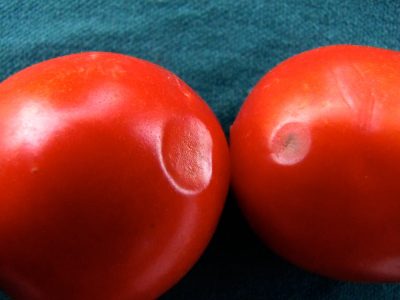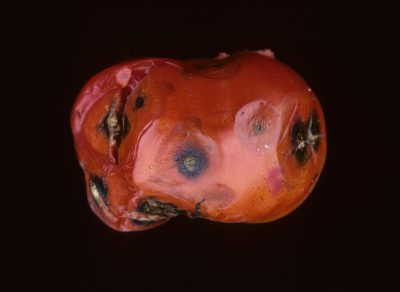Tomato Anthracnose
(Ripe Rot)
Author: Matthew DeBacco
Reviewed by: Shuresh Ghimire, Ph.D.
Associate Extension Educator
Extension Vegetable Specialist
Date of Publication: July 28, 2025
Introduction
Tomato anthracnose (ripe rot) is a fungal disease caused by several species of the fungus Colletotrichum, (Colletotrichum coccodes is the most common). It primarily affects ripe or overripe tomato fruit. During times of warm (optimal at 80°F, range 55–95°F) and wet or humid conditions, this disease can quickly spread on both the fruit and plant reducing overall yield. Additional conditions that are favorable to the spread of anthracnose include poorly drained soils or a reduction in plant foliage cover.


Symptoms
Fruit: Initially small, circular, water-soaked spots that are slightly sunken will appear on over ripened tomatoes. These lesions can form concentric rings and expand up to ½” in diameter while also getting deeper and darker. Looking toward the center of the spots, dark fungal structures may be seen, or if conditions remain very humid, the spores will have a salmon pink appearance to them. Individual lesions can group together resulting in a large rotting area and ultimately complete fruit decay. Note: Unripe green fruit may be infected, but not show any symptoms of Anthracnose until ripening begins.
Leaves and Stems: This type of infection is not as common. However, small, dark spots with yellow halos may appear on older leaves, and tiny lesions may occur on stems. While minimal, these are often missed and can provide the initial reservoir of the fungal spores.
Roots: Less commonly identified are root infections. These especially occur in mature plants and can be seen as black dots on the roots and lead to root rot.
Host Crops: Solanaceae family, Eggplant, Potatoes, Peppers and Watermelon. Also in field weeds.
Identification of Disease
The fungus (Colletotrichum species, primarily C. coccodes) survives as sclerotia (compact hardened masses of mycelium) or hyphae (branched filaments of mycelium) in infested tomato debris, soil, or on weed and crop hosts. The fungus can also be seed-borne.
Not to be Confused with:
Blossom End Rot - Water-soaked lesions, usually form on the lower side of the tomato fruit
Late Blight - Sunken spots on tomato fruit are less circular in appearance
Transmission/Vectors
Splashing water, wind, insects and human contact can spread the spores. The early infections are most common on the lower (older) portions of the plants that can work up the plant as the season progresses.
Management
There are two slicer-type tomato varieties that are resistant to anthracnose: Chef's Choice FI (orange) and Chef's Choice (red).
Cultural:
- Use drip irrigation and avoid overhead irrigation
- Grow tomatoes in a covered structure
- Avoid harvesting or pruning wet plants
- Practice crop rotation with non-solanaceous crops (e.g., corn, beans, or cover crop) for 3-4 years to reduce fungal buildup in soil
- Stake plants upright and mulch underneath to help improve air circulation and minimize soil splash contact
- Hot water seed treatment (122°F for 25 minutes) can help reduce early disease pressure.
Chemical:
Apply fungicides according to a disease forecasting system. Here are some examples of fungicides you can use: azoxystrobin plus difenoconazole (Quadris Top) Groups 11 & 3, chlorothalonil (Bravo Weather Stik) Group M05, and mancozeb (Dithane F45), Group M03. Additional fungicides labeled for organic production are polyoxin D zinc salt (OSO 5%SCOG, AKA Veggie Turbo 5 SCOG) Group 19 and hydrogen dioxide plus peroxyacetic acid (ZerotolOG) Group NC. Consult the New England Vegetable Management Guide for disease control products specific to field grown tomatoes.
References
Center for Agriculture, Food and the Environment at UMass Amherst. (2013, January 13). Solanaceous, Anthracnose: Vegetable. University of Massachusetts Amherst. https://www.umass.edu/agriculture-food-environment/vegetable/fact-sheets/solanaceous-anthracnose
McGrath, M. T. (2022, September 13). Anthracnose on tomatoes. Vegetable Pathology – Long Island Horticultural Research & Extension Center, Cornell University. https://blogs.cornell.edu/livegpath/gallery/tomato/anthracnose-on-tomatoes/
Olson, J. (2021, April 15). Anthracnose of Tomato. Oklahoma State University Extension. https://extension.okstate.edu/programs/digital-diagnostics/plant-diseases/anthracnose-of-tomato.html
UC IPM Pest Management Guidelines: Tomato. UC ANR Publication 3470. R.M. Davis (emeritus), G. Miyao (emeritus), K.V. Subbarao, J.J. Stapleton, B.J. Aegerter, B.W. Falk. University of California Statewide Integrated Pest Management Program. Available at: https://ipm.ucanr.edu/agriculture/tomato/anthracnose/
Consult and follow pesticide labels for registered uses. To avoid potential phytotoxicity problems, spot test before widespread use.
No discrimination is intended for any products not listed.
The information in this document is for educational purposes only. The recommendations contained are based on the best available knowledge at the time of publication. Any reference to commercial products, trade or brand names is for information only, and no endorsement or approval is intended. UConn Extension does not guarantee or warrant the standard of any product referenced or imply approval of the product to the exclusion of others which also may be available. The University of Connecticut, UConn Extension, College of Agriculture, Health and Natural Resources is an equal opportunity program provider and employer.